Last Updated on December 7, 2024 by Kittredge Cherry

AIDS spiritual resources for World AIDS Day include prayers, artwork, books, and icons such as patron saints of the AIDS pandemic and Jesus wearing a red ribbon. They are presented here for World AIDS Day, Dec. 1.
More than 40 years have passed since AIDS was first reported in the United States on June 5, 1981, now known as HIV Long-Term Survivors Awareness Day.
World AIDS Day supports everyone affected by HIV. The day is dedicated to prevention and treatment, and honors those who died of AIDS — more than nearly 700,000 people in the United States and 25 million people worldwide. It also honors the many living caregivers and volunteers who served in the context of HIV/AIDS, often amid prejudice or apathy. Decades later there is still no cure or vaccine for AIDS. Started in 1988, World AIDS Day was the first global health day for any disease. Dec. 1 also happens to be another holy day for LGBTQ people of faith: the birthday of gay martyr and hate-crime victim Matthew Shepard.
Saints with HIV/AIDS and patron saints of the pandemic
Some saints with HIV/AIDS are included in the LGBTQ Saints series at Q Spirit, such as historian John Boswell, Catholic brother Grant-Michael Ford, activist Marsha P Johnson, hate-crime victim Matthew Shepard, church leader James Tinney, and clergy/activist Steve Pieters.
Among historical saints, queer patron saints for AIDS include 16th-century Italian saint Aloysius Gonzaga and two medieval same-sex pairs who faced disease epidemics together with friendship and faith. Their man-to-man bonds speak to the LGBTQ community, where AIDS has a disproportionately large impact. The couples stand on each side of a chestnut tree, a symbol of life after death.
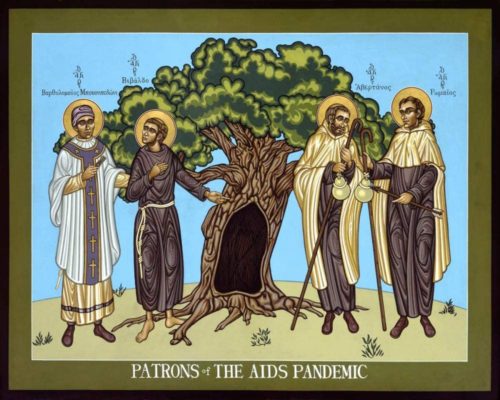
“Patrons of the AIDS Pandemic” by Lewis Williams, SFO. Prints are available at Amazon or Trinitystores.com.
“It is hoped that they offer solace to companions who have survived a loved one’s death, or to friends\family burdened by the death of two companions,” says the text accompanying the icon.
On the left are 13th-century Franciscans who ministered in an Italian leper colony: Blessed Bartolo Buonpedoni and Blessed Vivaldo. Bartolo got leprosy while caring for the sick, so he had to live in segregated housing. His loyal friend Vivaldo moved into the leper house with him, even though he himself had not contracted the disease. They lived together for 20 years until Bartolo’s death. Today there are effective treatments for leprosy, now known as Hansen’s disease. AIDS has taken its place as a dreaded and stigmatized disease. For more info, see the previous post Vivaldo and Bartolo: Love stronger than death for AIDS patron saints.
On the right stand 14th-century French Carmelite friars Saint Avertanus and Blessed Romeo, traveling companions who died together of the plague. Avertanus felt inspired to go to make a pilgrimage through Rome to the Holy Land, so he got permission and took Romeo with him. They faced rain and snow as they made an adventurous pilgrimage over the Alps from France to Italy. No Italian city would let them in, for an epidemic of plague was raging. Avertanus died first, followed a week later by Romeo.
The icon was painted by New Mexico artist Lewis Williams of the Secular Franciscan Order (SFO). He studied with master iconographer Robert Lentz and has made social justice a theme of his icons.
Aloysius Gonzaga is a 16th-century Italian saint who is associated with the LGBTQ community as a patron of people with AIDS and their caregivers. His Catholic feast day is June 21, the date of his death. While still a student, the young Jesuit died at age 23 as a result of caring for plague victims. Dozens of LGBTQ people with HIV/AIDS got support from the “Gonzaga Group” hosted by the Church of St. Francis Xavier in New York City for more than a decade. The church still has a side altar dedicated to Aloysius Gonzaga as an AIDS memorial. Some also consider him a queer saint because he renounced the traditionally masculine military career that his aristocratic family tried to force upon him.
Personal experiences at a church with AIDS
World AIDS Day holds great personal meaning for me. I lost many friends to AIDS when I was ministering in the LGBT community of San Francisco in the late 1980s. Back then there were no effective treatments and many gay men were dying of AIDS.
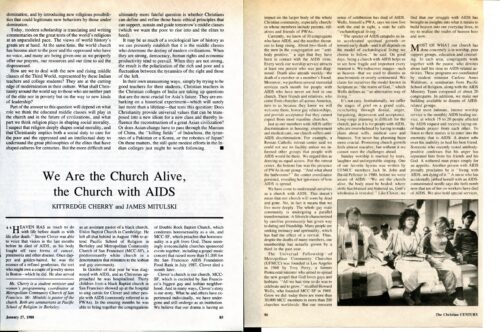
“We are the Church Alive, the Church with AIDS” by Kittredge Cherry and James Mitulski, appeared in Christian Century magazine on Jan. 27, 1988.
 I wrote about some of my AIDS ministry experiences for Christian Century magazine in a now-classic article titled “We Are the Church Alive, the Church with AIDS.” The 1988 article, co-authored with Jim Mitulski, is reprinted in the book The Church with AIDS: Renewal in the Midst of Crisis
I wrote about some of my AIDS ministry experiences for Christian Century magazine in a now-classic article titled “We Are the Church Alive, the Church with AIDS.” The 1988 article, co-authored with Jim Mitulski, is reprinted in the book The Church with AIDS: Renewal in the Midst of Crisis, edited by Letty Russell.
I still keep a small brick on my desk that says, “We are the body of Christ and we have AIDS.” It is a treasured gift from a friend who lived through those years with me at Metropolitan Community Church of San Francisco.
I remember being especially struck at the time by the words of Jack Pantaleo, who was co-founder and co-d of the AIDS InterFaith Network in San Francisco: “The real miracle is that anybody cares at all.”
For those who want to learn about — or remember — what it was like, I recommend the 2011 documentary We Were Here. With honesty and grace, the film examines the arrival and impact of AIDS on San Francisco. It focuses on give people who were there before and during the AIDS crisis and has lots of film documenting the LGBT experience in the San Francisco over the decades. For me everyone in the movie looked like someone I knew. ALL the faces were familiar! It seemed like I recognized every face, even though they were strangers. Watching the video is both heartbreaking and inspirational.
Steve Pieters: Gay minister, longtime AIDS survivor and friend
I celebrate the life of my friend and colleague Steve Pieters, gay clergyman, LGBTQ activist and one of the longest-surviving AIDS patients. He died on July 8, 2023 in Los Angeles at age 70. I wrote these personal memories while obituaries and tributes from luminaries flooded the Internet with his dramatic life story.
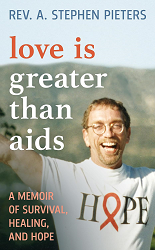 He was diagnosed in 1982, back when AIDS was still called Gay-Related Immune Disorder (GRID). Doctors predicted he would die before 1985, but Steve lived with HIV/AIDS for more than 40 years. In the end, he died after being hospitalized with an infection after treatment for cancer. Funeral arrangements are pending.
He was diagnosed in 1982, back when AIDS was still called Gay-Related Immune Disorder (GRID). Doctors predicted he would die before 1985, but Steve lived with HIV/AIDS for more than 40 years. In the end, he died after being hospitalized with an infection after treatment for cancer. Funeral arrangements are pending.
In 1984 he became “patient number 1” on the first anti-viral drug trial for HIV/AIDS in 1984. Two weeks after a near-death experience, he received a life-changing invitation. Televangelist Tammy Faye Bakker wanted to interview him for “Tammy’s House Party” on the PTL Television Network. It was the largest Christian network in the world at the time, with viewers in 13 million U.S. homes plus 40 other countries.
The ground-breaking 1985 broadcast shifted public opinion. It was the first time that a televangelist interviewed a gay man, and one of the first positive media portrayals of a gay man with AIDS. The landmark interview is re-enacted a major event in the 2021 film “The Eyes of Tammy Faye,” starring Jessica Chastain in an Oscar-winning performance as Tammy Faye.
His motto, and the title of his first autobiography, was “I’m Still Dancing.” A new memoir, “Love is Greater Than AIDS: A Memoir of Survival, Healing, and Hope,” was published April 2024 by Rowman & Littlefield.
Spiritual art for World AIDS Day
A variety of artworks connect AIDS with Christ and the saints. A traditional Jesus wears a red ribbon to show AIDS solidarity in “Surely He Has Borne Our Griefs and Known Our Sorrows” by Tobias Haller. He is an iconographer, author, composer, and vicar of Saint James Episcopal Church in the Bronx. He wrote “Reasonable and Holy: Engaging Same-Sexuality.” Haller enjoys expanding the diversity of icons available by creating icons of LGBTQ people and other progressive holy figures as well as traditional saints. He and his spouse were united in a church wedding more than 30 years ago and a civil ceremony after same-sex marriage became legal in New York.
William Hart McNichols shows Francis of Assisi, one of the most beloved saints of all time, embracing a gay Jesus with AIDS in “St. Francis ‘Neath the Bitter Tree.” Words on the cross proclaim that Christ is an “AIDS leper” as well as a “drug user” and “homosexual,” outcast groups at high risk for getting AIDS. The two men gaze intently at each other with unspeakable love as Francis hugs the wounded Christ. It was commissioned in 1991 by a New Jersey doctor who worked with AIDS patients, and is discussed in the book Art That Dares: Gay Jesus, Woman Christ, and More by Kittredge Cherry.
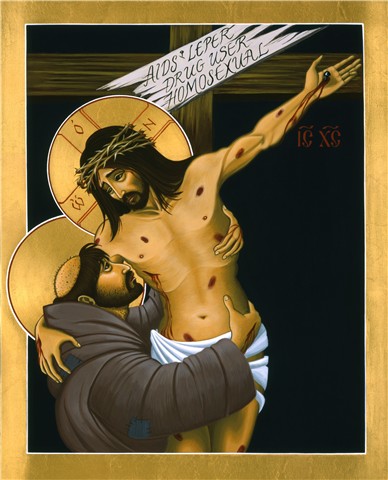
“St. Francis ‘Neath the Bitter Tree” by © William Hart McNichols
An AIDS Pieta is included in the controversial 1998 “Ecce Homo” series by Swedish photographer Elisabeth Ohlson. She recreated 12 scenes from Christ’s life using contemporary LGBTQ models and locations.
Each “Jesus” got to pick which scene he wanted to play. A gay man who was about to die of AIDS chose the Pieta, resulting in a poignant image that sheds new light on Michelangelo’s prototype sculpture of the Madonna cradling her dead son. Ohlson Wallin let “Jesus” choose who would be his grieving mother, and he picked a female leather bar employee who was well known in Stockholm for mothering gay men. The mood was quiet and somber as they posed at the door to the AIDS ward of a Stockholm hospital. Behind that door Ohlson Wallin said goodbye to three friends.
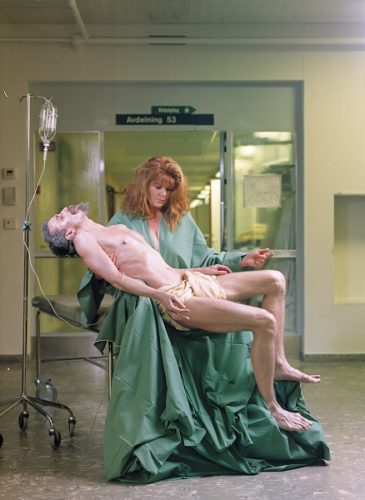
“Pieta” (from “Ecce Homo”) by Elisabeth Ohlson
The man in Ohlson Wallin’s Pieta said he hoped that people would remember him by the picture after his death—but this “Jesus” experienced his own personal resurrection. Shortly after the photo shoot, he began taking the new AIDS drug cocktail. “The Jesus is still alive!” Ohlson Wallin marveled a decade later. And the AIDS ward no longer exists. The “Ecce Homo” series is also discussed in the book Art That Dares: Gay Jesus, Woman Christ, and More by Kittredge Cherry.
An altarpiece by gay artist Keith Haring is the centerpiece of the AIDS Interfaith Memorial Chapel at Grace Cathedral in San Francisco. He completed it just two weeks before his own death from AIDS in 1990. The massive 5-by-8 foot triptych is cast bronze and covered in white gold leaf. Titled “The Life of Christ,” it shows his birth, death and resurrection provoking strong reactions from people and angels in Haring’s characteristic style of faceless, abstract figures. There are at least nine versions of the triptych, including those at the Cathedral of St. John the Divine in New York City and Saint-Eustache Church in Paris, France. “The AIDS Chapel is a statement that compassion must be at the heart of committed response to the disease,” says the description at AIDSmemorial.info.
The triptych is portrayed in a mixed-media work by Catholic San Francisco artist Stefan Salinas. It appears in his 2020 book “The Concert and the Closet: A Comic Book on Depression, Moments of Grace, and Closeted Gay Christians.”
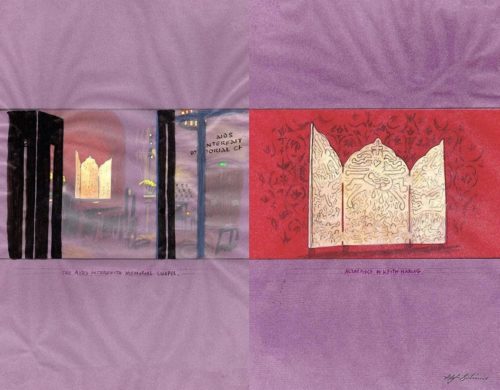
“AIDS Interfaith Memorial Chapel” by Stefan Salinas. Prints are available at his Etsy shop.
Jesus in depicted as a man with AIDS in “Man of Sorrows: Christ with AIDS” by gay American artist and theologian Maxwell Lawton (1956-2006). Archbishop Desmond Tutu called it “wonderful” and many people love the painting, but some denounced it as blasphemy and threatened to slash it when it was displayed at St. George’s Anglican cathedral in Cape Town, South Africa.
Lawton grew up in the Southern Baptist church, where his father was a minister. His church excommunicated him because he came out as a gay Christian. Lawton was a Wesley Theological Seminary student with AIDS when he accepted an invitation in 1994 to go to Cape Town to help an AIDS ministry by doing a version of the painting there. A video news report includes interviews with the artist, the archbishop and church-goers.
In a moving statement on his website, he describes how his own AIDS experiences led him to have a vision of “Christ, covered in AIDS cancer lesions with his head bowed, nude, wearing only a crown of thorns. I knew I had to paint it.” His painting appears on the cover of the 2018 memoir “Ordained by Angels: The Memoir of an AIDS Chaplain” by Jerry R Anderson.
AIDS is connected with the suffering of Christ in the painting of Station 10 from “Stations of the Cross: The Struggle For LGBT Equality” by Mary Button. Jesus is stripped of his garments beside images of the AIDS virus. The round structure of the human immunodeficiency virus forms a halo around Jesus’ head. Jesus being stripped is a scene of loss… and the LGBT community lost thousands of people due to AIDS. Button matches scenes from Christ’s journey to Calvary with milestones from the last 100 years of LGBT history in her LGBT Stations series. For an overview of all 15 paintings in the series, see my article “LGBT Stations of the Cross shows struggle for equality.”
 |
|
Christ with Ants from theDavid Wojnarowicz video
“A Fire in My Belly” |
Another artist who used Christian imagery to express the suffering and holiness of the AIDS experience was David Wojnarowicz. A vocal critic of the church’s silence during the AIDS crisis, he mixed gay imagery with religious symbols from his Roman Catholic childhood. He was a frequent target of the religious right during the culture wars of 1980s. Controversy continued in 2010 when the Smithsonian removed his video “A Fire in My Belly” from exhibit because religious conservatives objected to his use of a crucifix to symbolize AIDS patients. For more info, see my article “Smithsonian censors gay artist when conservatives attack.”
An artwork supporting people with AIDS is “Il Martir (The Martyr)” by Armando Lopez. For the story behind the painting, see my previous post, “Art honors AIDS martyrs on World AIDS Day.”
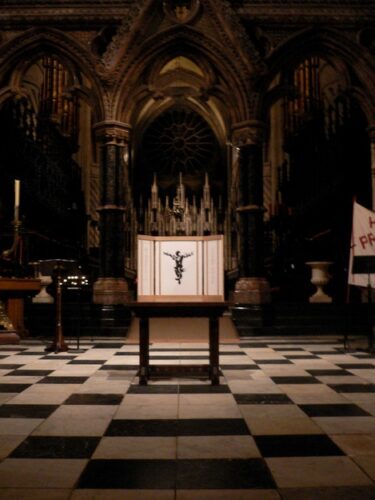
“Christ has AIDS” by Ewan Clayton.
British calligrapher Ewan Clayton created an icon of Christ with AIDS for the diocese of Durham, United Kingdom. An image of Jesus on the cross is formed by the words “Christ has AIDS.” His altarpiece with this image was dedicated at the Durham Cathedral on World AIDS Day in 2005. The AIDS icon forms a triptych with panels on each side of the crucifix offering a prayer from South Africa. It concludes, “We thank you that on the cross Jesus took all stigma onto himself that we might be free. Grant this liberation may be known by all living with AIDS/HIV.” Clayton’s AIDS icon is described in depth by scholar Joanna Homrighausen in the article “Liturgical Letters” in the March 2024 issue of the Journal of Interreligious Studies.
Books on AIDS and religion, spirituality and art
New books continue to be published about AIDS, sexuality and religion.
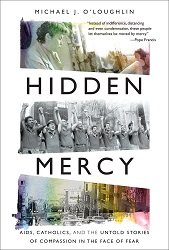
“Hidden Mercy: AIDS, Catholics, and the Untold Stories of Compassion in the Face of Fear” by Michael J. O’Loughlin.
Little-known lives of LGBTQ Catholics and allies offer inspiration as revealed by a gay Catholic journalist. Courageous individual Catholics heroically helped people with AIDS during the AIDS crisis of the 1980s and ‘90s, even though the Catholic church was cracking down on LGBTQ people. A young priest sees himself in the many gay men dying of AIDS and comes out himself. An HIV+ Catholic loses his partner to AIDS and focuses on his health by fleeing church rejection. Artist William Hart McNicols’ story is told. The author is the national correspondent for America magazine and former national reporter for the Boston Globe. He has written for the Atlantic, Washington Post and many other news media. Published by Broadleaf Books, 2021.
“To Make the Wounded Whole: The African American Struggle against HIV/AIDS” by Dan Royles. Winner, 2020-21 LGBTQ Religious History Award. Honorable Mention, 2021 John Boswell Prize, The Committee on Lesbian, Gay, Bisexual, and Transgender History, American Historical Association. Published by University of North Carolina Press, 2020.
“Let the Record Show: A Political History of ACT UP New York, 1987-1993” by Sarah Schulman. A 2021 New York Times Book Review Notable Book and a New York Times Book Review Editors’ Choice. Includes a spectacular treatment of the Stop the Church action. One of NPR’s Best Books of 2021. Published by Picador, 2021.
A gay Episcopal priest looks back at how his life was shaped by AIDS and the struggle for LGBTQ church acceptance in a new book published in November 2018: “Ordained by Angels: The Memoir of an AIDS Chaplain” by Jerry R Anderson. Ordained in 1968, he came out as gay in 1981 and has served parishes in the Chicago, northern Michigan, Washington, DC, southeast Florida and Los Angeles. The memoir explores how Anderson kept his faith in a loving God and maintained his sanity as he faced the deaths of loved ones and pushback from conservative elements of the church. Gene Robinson, the first openly gay Episcopal bishop, endorsed the book. The cover art is “Man of Sorrows: Christ with AIDS” by gay American artist and theologian Maxwell Lawton.
“Scarlet Ribbons: A Priest with AIDS” by Rosemary Bailey is the story of a gay Anglican priest with AIDS, written by his sister.
Art and HIV/AIDS activism are examined by looking the origins and use of graphic-design images used by the movement. “After Silence: A History of AIDS through Its Images” by Avram Finkelstein was published in November 2017 by the University of California Press. The author is co-founder of the Silence = Death collective. His work is in the permanent collections of many major museums.
“Religion, Flesh, and Blood: The Convergence of HIV/AIDS, Black Sexual Expression, and Therapeutic Religion” by Pamela Leong, 2015. Successful AIDS ministry by one black LGBT congregation in Unity Fellowship is the focus of a rich case study by a sociology professor. She describes how they blend African-American Christianity with the therapeutic ethic of American pop culture. The author focuses on the Los Angeles congregation through field work, interviews and analysis of sermons. Unity Fellowship founder Carl Bean is discussed in depth. Leong is assistant professor of sociology at Salem State University in Massachusetts.
“After the Wrath of God: AIDS, Sexuality, and American Religion” by Anthony M. Petro, 2015. The religious history of AIDS in America is examined by a Boston University religion professor. He goes way beyond the usual discussion of the Religious Right to cover a wide range of mainline Protestant, evangelical, and Catholic groups as well as AIDS activist organizations. The author reveals how the AIDS crisis prompted American Christians to start discussing homosexuality, fostering a moral discourse whose legacy includes abstinence education and same-sex marriage. This detailed and discerning history was published by the prestigious Oxford University Press. The section on Metropolitan Community Churches includes the ministry of long-time AIDS survivor Stephen Pieters.
A book released in 2014, “Rebels Rebel: AIDS, Art and Activism in New York, 1979-1989” by Tommaso Speretta, looks at some of the many ways that AIDS sparked the creation of radical art demanding social change.
World AIDS Day prayer
A spiritual response it provided by the following AIDS prayer by Diann L. Neu, cofounder and codirector of the Women’s Alliance for Theology, Ethics and Ritual (WATER). It was published in Equal Rites: Lesbian and Gay Worship, Ceremonies, and Celebrations:
____
One Person: Compassionate Holy One, open our hearts and minds and hands so that we may connect ourselves to the global community of others responding to AIDS as we pray:
We remember all the women, men, and children in this country and around the world who are living with AIDS.
All: Justice demands that we remember and respond.
One: We remember all who care for people living and dying with AIDS in their homes, in hospices, and in support centers.
All: Justice demands that we remember and respond.
One: We remember all who are involved in research and hospital care that they may respect the dignity of each person.
All: Justice demands that we remember and respond.
One: We remember all partners who are left mourning for their beloved ones.
All: Justice demands that we remember and respond.
One: We remember all parents who learn the truth of their children’s lives through their process of facing death….
We remain vigilant,
Until a cure for AIDS is found,
Until those dying with AIDS are comforted,
Until truth sets us free,
Until love drives out injustice.
We shall not give up the fight.
____

Links for World AIDS Day spiritual resources
“We are the Church Alive, the Church with AIDS” by Kittredge Cherry and Jim Mitulski (Christian Century magazine, Jan. 27, 1988:
PDF or html
Christ’s torment and queer suffering: More on Wojnarowicz censorship (Jesus in Love)
XIV: Niccolo Cosme’s interpretation of the 14 Stations of the Cross for HIV and AIDS (drinkmanila.com)
Timeline: 30 Years of AIDS in Black America (PBS)
Hidden in a New York choir loft, an early AIDS memorial faces an uncertain future (America Magazine)
___
Translations
To read this article in Spanish, go to:
Santos Avertanus, Romeo, Bartolo y Vivaldo: Patronos de la pandemia del VIH/SIDA (Santos Queer)
To read this article in Russian, go to:
Иконография ВИЧ/СПИДа (http://www.nuntiare.org)
To read this article in Italian, go to:
I segni della speranza, i santi e l’epidemia dell’AIDS (gionata.org)
___
Top image credit:
“Surely He Has Borne Our Griefs and Known Our Sorrows” by Tobias Haller
___
This post is part of the LGBTQ Calendar series by Kittredge Cherry. The series celebrates religious and spiritual holidays, events in LGBTQ history, holy days, feast days, festivals, anniversaries, liturgical seasons and other occasions of special interest to lesbian, gay, bisexual, transgender and queer people of faith and our allies.
This article was originally published on Q Spirit on Dec. 1, 2016, was expanded with new material over time, and most recently updated on Dec. 7, 2024.
Copyright © Kittredge Cherry. All rights reserved.
Qspirit.net presents the Jesus in Love Blog on LGBTQ spirituality.



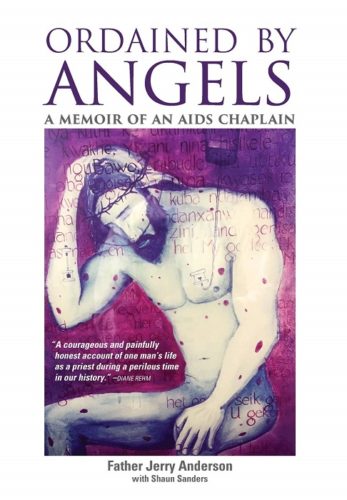



















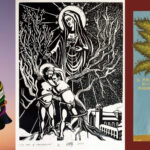

Trackbacks/Pingbacks